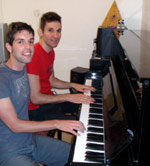How to Read Piano Notes - Free Beginner Piano Lessons
Home »Piano Notes
| Click here if you haven't signed toPiano Playground, our free E-zine yet. Make sure you do that in order to get the username and password codes for the piano sheets and tabs we provide for each piano tutorial and lesson (And I'll keep you posted with the new piano lessons and videos on our site). |
In this page I offer different kinds of piano lessons on reading notes. I'll first introduce you to the instrument, then we're going to learn to orient ourselves on the piano. Finally we're going to be learning the play the piano and while reading piano notes on the staff.
This is how I'm teaching piano with these beginning piano lessons; you're going to be learning to play the piano based on reading a written content and videos which are added to each and every beginning piano lesson. (We're in the process...)

What's so great about the piano notes lessons is that once you've learned a certain subject I'll direct you to free piano sheets the cover this subject so you'll be learning to play the piano efficiently.
-
In this first piano lessons I'm going to introduce you to the instrument. We'll the discuss the names of the fingers and the correct hand position for piano playing.
-
With a simple layout of piano keys I'm going to teach you how to orient yourself on the piano and learn to know the names of the piano keys.
-
Before you'll start reading piano notes I thought you should know you don't really need it in order to start playing piano.
This page will blow your mind off since you'll realize that with developing your musical ear you'd be able to play simple melodies by ear.
-
This piano lesson shows you how the rhythm helps us to count the length of piano notes.
Reading Notes on the Treble Staff (Notes above middle C)
It's time to get to know the staff and how to the notes on it. I'll make it short and clear so let's get going.
-
In this short and clear piano lesson I'll show you how to draw the Treble Clef.
Reading Notes on the Bass Staff (Notes Under Middle C).
This piano lesson is dedicated to notes under middle C which are written on the Bass Clef (Mostly played with the left hand). I'll give you some handy tips that will help you to read them fast.
Reading Notes on The Grand Staff (For Both Hands)
My students told me that the tips on this piano lesson helped them to read piano notes with both hands two times faster then they did before.
Reading Harmonic Intervals on the Piano Staff
This next lesson will show you how to read two notes played together on the piano staff.
-
In this page we're going to cover a new time signature and learn about the dotted half note.
-
Silence is the opposite of a sound. In this piano lesson we're going to learn how to combine both elements in musical pieces, starting with the quarter rest.
-
Next on the line is the half rest - a sign of a rest that lasts two counts
-
the last rest sign we're going to cover for now is the whole rest. A sign of rest that lasts four counts.
-
This lesson concerns both reading music notes and piano technique. I'll teach you how to read the dyanamics signs and give you some exercises to help you play them in a convincing manner on the piano.
Sudden and Gradual Dyanamic Signs
Here's how to play surprise your listeners with sudden dynamic changes and excite them with gradual dynamic signs.
-
Two eighth notes are played in a quarter note. They enrich the variety of the rhythm in our piano pieces. Let's learn to read and play them.
-
It is time to learn to read and play, and use the black keys and combine them in our musical pieces. In this piano lesson we'll learn to read piano pieces with a sharp sign.
-
In the previous lesson we talked about raised notes, and this time we're going to talk about lowered notes indicated by the flat sign.
-
The Natural Sign Cancels a Flat or a Sharp. In this piano lesson we'll learn to play some musical pieces with the natural sign.
-
In real life people speak in different accents. That's what makes the way they talk so unique and expressive. Let's talk about musical accent mark to have our own style in piano playing.
-
In this page we're going to cover a few very important basic music terms for beginners such as the Repeat Signs, the 8va, the incomplete measure, the first and second ending, the D.C al Fine and D.S al Fine
-
The next tone length we're going to discuss is the sixteenth note.
-
We walked a long road on the path of reading notes. Now let's talk about different Tempos (which is the rate of speed and mood you're going to play).
-
In order to make our playing more intersting, let's add new exciting rhythms. The dotted notes will help us with that.
-
Triplets or Triolas divide a quarter or a half note to three equal units instead of two. Let's see how to read and play them on the piano.
-
Why do we use the Double Sharp and the Double flat signs. Here's a free piano lesson about the double accidentals.
-
Here's a review of musical terms for those who lost their way somewhere on the road.
Return from Read Piano Notes to Home Page














